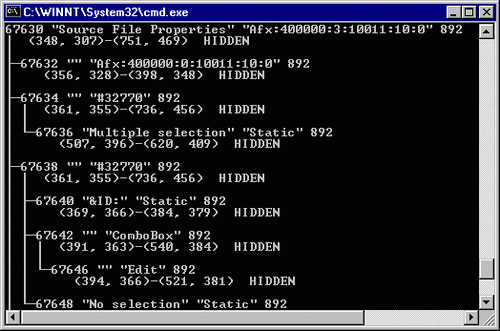
Introduction
This console program uses the GetTopWindow and
GetNextWindow calls recursively to iterate through
the entire tree of windows in the system. The program outputs information on these
windows in a text based tree view.
For each window, it shows the title, the registered class,
the handle of the owner process, the coordinates, and whether or not the window is visible.
Using the code
The main work of the program is done in the PrintChildrenWindows function.
This steps through the z-order, listing all windows, and recursively steps into the
list of child windows for each window it visits. The output is a text tree that looks something
like this:
133114 "windump - Microsoft Visual C++ - [windump.cpp]"
"Afx:400000:8:10011:0:10505" 892
| (-4, -4)-(1028, 744) VISIBLE
|
+-133110 "" "Afx:400000:0:10011:10:0" 892
| (0, 723)-(1024, 740) VISIBLE
|
+-133118 "" "Afx:400000:8" 892
| | (0, 19)-(1024, 106) VISIBLE
| |
| +-67628 "" "Afx:400000:b:10011:10:0" 892
| | (367, 77)-(655, 107) VISIBLE
| |
| +-67626 "" "Afx:400000:b:10011:10:0" 892
| | (607, 47)-(733, 77) VISIBLE
| |
| +-67614 "" "Afx:400000:b:10011:10:0" 892
| | | (-1, 47)-(607, 77) VISIBLE
| | |
| | +-67616 "" "AfxWnd42" 892
| | | (193, 51)-(230, 73) VISIBLE
| | |
...
The first line displays the handle, the title, the class name,
and the handle of the owner process.
The second line displays the coordinates (left, top)-(right, bottom),
and whether or not the window is currently visible.
void PrintChildrenWindows(HWND hwnd, int level)
{
hwnd = GetTopWindow(hwnd);
if(!hwnd)
return;
while(hwnd)
{
char levelSpace[1024];
char nameBuffer[WINBUFF_SIZE];
char typeBuffer[WINBUFF_SIZE];
GetWindowText(hwnd, nameBuffer, WINBUFF_SIZE);
RealGetWindowClassA (hwnd, typeBuffer, WINBUFF_SIZE);
GenerateTreeString(levelSpace,
level,
GetNextWindow(hwnd, GW_HWNDNEXT) ? true : false,
GetTopWindow(hwnd) ? true : false,
false);
printf("%s%d \"%s\" \"%s\" %d\n",levelSpace, hwnd,
nameBuffer, typeBuffer, GetWindowThreadProcessId(hwnd, NULL));
GenerateTreeString(levelSpace,
level,
GetNextWindow(hwnd, GW_HWNDNEXT) ? true : false,
GetTopWindow(hwnd) ? true : false,
true);
RECT rect;
GetWindowRect(hwnd, &rect);
printf("%s (%d, %d)-(%d, %d)", levelSpace,
rect.left, rect.top, rect.right, rect.bottom);
if(IsWindowVisible(hwnd))
printf(" VISIBLE\n");
else
printf(" HIDDEN\n");
printf("%s\n", levelSpace);
PrintChildrenWindows(hwnd, level + 1);
hwnd = GetNextWindow(hwnd, GW_HWNDNEXT);
}
}
This is the recursive function which prints the window information.
At the top level, hwnd is NULL.
Calling GetTopWindow(NULL) gets the top window in the z-order.
It then loops, calling
hwnd = GetNextWindow(hwnd), to retrieve each successive
window in the z-order. Also, it calls
itself for each window, with hwnd equal to the window just printed.
This causes the loop to process all child windows in the same way as
GetTopWindow(hwnd /*!= NULL*/) gets the first child window
of hwnd. If there are no child windows, GetTopWindow
returns NULL, and we return, unwinding the recursion.
Points of interest
This program also contains a function called isFlagInArgs which could easily
be extracted and used in other command line utilities to interpret command line arguments.
I was born and raised in Dayton, Ohio. I acquired an NCR PC Model 4 when I was 8, and was writing fairly complex GW-BASIC programs by the time I was ten. Educated formally at Wright State University, I now work for an undisclosed company doing platform level work with Linux, Windows, and, sadly still, DOS (Why the &%^& won't [name withheld] %^&%$%# upgrade already?!).
 General
General  News
News  Suggestion
Suggestion  Question
Question  Bug
Bug  Answer
Answer  Joke
Joke  Praise
Praise  Rant
Rant  Admin
Admin 






